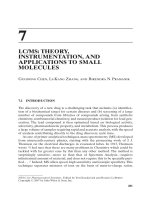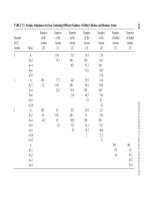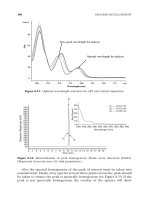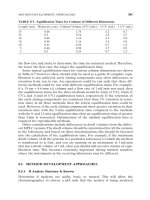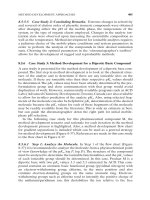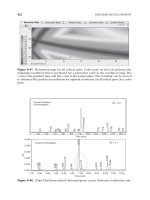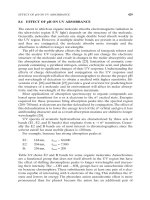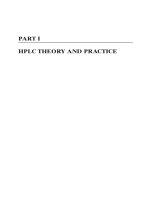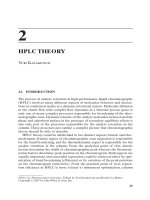kazakevich - hplc for pharmaceutical scientists (wiley, 2007)
Bạn đang xem bản rút gọn của tài liệu. Xem và tải ngay bản đầy đủ của tài liệu tại đây (16.9 MB, 1,135 trang )
HPLC FOR
PHARMA
CEUTICAL
SCIENTISTSHPLC FOR
PHARMA
CEUTICAL
SCIENTISTS
Edited by
YURI KAZAKEVICH
Seton Hall University
South Orange, New Jersey
ROSARIO LOBRUTTO
Novartis Pharmaceuticals
East Hanover, New Jersey
WILEY-INTERSCIENCE
A JOHN
WILEY & SONS, INC., PUBLICATION
Copyright © 2007 by John Wiley & Sons, Inc. All rights reserved
Published by J
ohn Wiley & Sons, Inc., Hoboken, New Jersey
Published simultaneously in Canada
No part of this publication may be reproduced, stored in a retrieval system, or transmitted in
any form or by any means, electronic, mechanical, photocopying, recording, scanning, or
otherwise, except as permitted under Section 107 or 108 of the 1976 United States Copyright
Act, without either the prior written permission of the Publisher, or authorization through
payment of the appropriate per-copy fee to the Copyright Clearance Center, Inc., 222
Rosewood Drive, Danvers, MA 01923, (978) 750-8400, fax (978) 750-4470, or on the web at
www.copyright.com. Requests to the Publisher for permission should be addressed to the
Permissions Department, John Wiley & Sons, Inc., 111 River Street, Hoboken, NJ 07030,
(201) 748-6011, fax (201) 748-6008, or online at />Limit of Liability/Disclaimer of Warranty: While the publisher and author have used their best
efforts in preparing this book, they make no representations or warranties with respect to the
accuracy or completeness of the contents of this book and specifically disclaim any implied
warranties of merchantability or fitness for a particular purpose. No warranty may be created
or extended by sales representatives or written sales materials. The advice and strategies
contained herein may not be suitable for your situation. You should consult with a professional
where appropriate. Neither the publisher nor author shall be liable for any loss of profit or any
other commercial damages, including but not limited to special, incidental, consequential, or
other damages.
For general information on our other products and services or for technical support, please
contact our Customer Care Department within the United States at (800) 762-2974, outside the
United States at (317) 572-3993 or fax (317) 572-4002.
Wiley also publishes its books in a variety of electronic formats. Some content that appears in
print may not be available in electronic formats. For more information about Wiley products,
visit our web site at www.wiley.com.
Library of Congress Cataloging-in-Publication Data:
HPLC for pharmaceutical scientists / edited by Yuri Kazakevich, Rosario LoBrutto.
p. cm.
Includes bibliographical references and index.
ISBN-13: 978-0-471-68162-5 (cloth)
ISBN-10: 0-471-68162-8 (cloth)
1. High performance liquid chromatography. 2. Drugs–Analysis. 3. Clinical chemistry.
I. Kazekevich, Yuri. II. LoBrutto, Rosario.
RS189.5.H53H75 2007
615′.1901–dc22
2006046395
Printed in the United States of America
10987654321
CONTENTS
PREF
ACE xxi
CONTRIBUTORS xxv
PART I HPLC THEORY AND PRACTICE 1
1 Introduction 3
Yuri Kazakevich and Rosario LoBrutto
1.1 Chromatography in the Pharmaceutical World, 3
1.2 Chromatographic Process, 4
1.3 Classification, 4
1.4 History of Discovery and Early Development
(1903–1933), 6
1.5 General Separation Process, 8
1.5.1 Modern HPLC Column, 9
1.5.2 HPLC System, 9
1.6 Types of HPLC, 10
1.6.1 Normal-Phase Chromatography (NP HPLC), 10
1.6.2 Reversed-Phase HPLC (RP HPLC or RPLC), 11
1.6.3 Ion-Exchange Chromatography (IEX), 13
1.6.4 Size-Exclusion Chromatography (SEC), 14
1.7 HPLC Descriptors (Vr, k, N, etc.), 15
1.7.1 Retention Volume, 15
1.7.2 Void Volume, 16
1.7.3 Retention Factor, 17
1.7.4 Selectivity, 18
v
1.7.5 Efficiency, 19
1.7.6
Resolution, 22
References, 23
2 HPLC Theory 25
Yuri Kazakevich
2.1 Introduction, 25
2.2 Basic Chromatographic Descriptors, 26
2.3 Efficiency, 27
2.4 Resolution, 32
2.5 HPLC Retention, 34
2.6 Retention Mechanism, 35
2.7 General Column Mass Balance, 37
2.8 Partitioning Model, 39
2.9 Adsorption Model, 40
2.10 Total and Excess Adsorption, 41
2.11 Mass Balance in Adsorption Model, 42
2.12 Adsorption of the Eluent Components, 43
2.13 Void Volume Considerations, 47
2.14 Thermodynamic Relationships, 49
2.14.1 Effect of the Eluent Composition, 53
2.15 Adsorption-Partitioning Retention Mechanism, 54
2.16 Secondary Equilibria, 57
2.16.1 Inclusion of Secondary Equilibria in the Mass
Balance, 58
2.16.2 Salt Effect, 62
2.17 Gradient Elution Principles, 67
2.18 Types of Analyte Interactions with the Stationary Phase, 69
2.19 Conclusion, 70
References, 71
3 Stationary Phases 75
Yuri Kazakevich and Rosario LoBrutto
3.1 Introduction, 75
3.2 Type of Packing Material (Porous, Nonporous, Monolithic), 77
3.3 Base Material (Silica, Zirconia, Alumina, Polymers), 77
3.4 Geometry, 80
3.4.1 Shape (Spherical/Irregular), 80
3.4.2 Particle Size Distribution, 80
3.4.3 Surface Area, 81
3.4.4 Pore Volume, 82
3.4.5 Surface Geometry, 84
3.5 Adsorbent Surface Chemistry, 85
3.5.1 Surface Chemistry of the Base Material, 85
vi CONTENTS
3.5.2 Silica, 86
3.5.3
Silica Hybrid, 88
3.5.4 Polymeric Packings, 89
3.5.5 Zirconia (Metal Oxides), 90
3.5.6 Porous Carbon (or Carbon-Coated Phases), 90
3.6 Surface of Chemically Modified Material, 91
3.6.1 Limits of Surface Modification, 93
3.6.2 Chemical Modification, 93
3.6.3 Types of Bonded Phases, 101
3.6.4 Structure of the Bonded Layer, 103
3.6.5 Density of Bonded Ligands, 105
3.6.6 Residual Silanoles, 110
3.6.7 Surface Area of Modified Adsorbent, 110
3.7 Polymer-Based Adsorbents, 113
3.8 Stationary Phases for Chiral Separations, 115
3.8.1 Polysaccharide-Coated Phases, 115
3.8.2 Pirkle-Type Phases, 116
3.8.3 Protein Phases, 116
3.8.4 Molecular Imprinted Polymers for Chiral
Separations, 117
3.9 Columns, 118
3.9.1 Capillary/Monolithic/Packed Columns, 118
3.9.2 Column Cleaning, 126
3.9.3 Column Void Volume, 128
3.9.4 Mass of Adsorbent in the Column, 130
References, 132
4 Reversed-Phase HPLC 139
Rosario LoBrutto and Yuri Kazakevich
4.1 Introduction, 139
4.2 Retention in Reversed-Phase HPLC, 140
4.3 Stationary Phases for RPLC, 142
4.4 Mobile Phases for RPLC, 145
4.4.1 Eluent Composition and Solvent Strength of the
Mobile Phase, 146
4.4.2 Type of Organic Modifier, 151
4.4.3 Selectivity as a Function of Type and Concentration
of Organic Composition, 153
4.5 pH Effect on HPLC Separations, 158
4.5.1 Mobile-Phase pH. Practical Considerations, 158
4.5.2 Analyte Ionization (Acids, Bases, Zwitterions), 160
4.5.3 pK
a
and pK
b
Relationship, 161
4.5.4 Retention of Ionizible Analytes in Reversed-Phase
HPLC, 161
CONTENTS vii
4.5.5 Case Studies: Effects of pH on Ionizable Analyte
Retention,
166
4.5.6 Mobile-Phase pH, 171
4.5.7 Analyte Dissociation Constants, 179
4.5.8 Determination of Chromatographic pK
a
, 180
4.6 Effect of Organic Eluent Composition on Analyte
Ionization, 182
4.6.1 Effect of Organic Modifier on Basic Analyte pK
a
Shift, 182
4.6.2 Effect of Organic Modifier on Acidic Analyte pK
a
Shift, 186
4.7 Synergistic Effect of pH, Organic Eluent, and Temperature on
Ionizable Analyte Retention and Selectivity, 189
4.8 Examples of Applying pH Shift and Analyte pK
a
Shift Rules, 191
4.9 Effect of Temperature on Analyte Ionization, 195
4.10 Ion-Interaction Chromatography, 197
4.10.1 Introduction, 197
4.10.2 Double Layer Theory, 198
4.10.3 Ion Pairs, 200
4.10.4 Chaotropic Effect, 206
4.11 Concluding Remarks, 227
References, 228
5 Normal-Phase HPLC 241
Yong Liu and Anant Vailaya
5.1 Introduction, 241
5.2 Theory of Retention in Normal-Phase Chromatography, 241
5.3 Effect of Mobile Phase on Retention, 245
5.4 Selectivity, 248
5.4.1 Effect of Analyte Structure, 248
5.4.2 Types of Stationary Phases, 249
5.5 Applications, 251
5.5.1 Analytes Prone to Hydrolysis, 251
5.5.2 Extremely Hydrophobic Compounds, 252
5.5.3 Separation of Isomers, 253
5.5.4 Carbohydrates, 256
5.5.5 Separation of Saturated/Unsaturated Compounds, 257
5.6 Conclusions, 257
References, 257
6 Size-Exclusion Chromatography 263
Yuri Kazakevich and Rosario LoBrutto
6.1 Separation of the Analyte Molecules by Their Size, 263
6.2 Molecular Size and Molecular Weight, 266
viii CONTENTS
6.3 Separation Mechanism, 267
6.4
Calibration, 268
6.5 Columns, 271
6.6 Molecular Weight Distribution, 273
6.7 Effect of Eluent, 274
6.8 Effect of Temperature, 274
6.9 Detectors, 275
6.10 Solving Mass Balance Issues, 275
6.11 Aqueous SEC Applications, 276
References, 278
7 LC/MS: Theory, Instrumentation, and Applications to Small
Molecules 281
Guodong Chen, Li-Kang Zhang, and Birendra N. Pramanik
7.1 Introduction, 281
7.2 Ionization Methods and LC/MS Interfaces, 282
7.2.1 Ionization Methods, 282
7.2.2 Historical View of Interfaces, 286
7.2.3 Common Interfaces, 288
7.2.4 Special Interfaces, 290
7.3 Mass Analyzers, 291
7.3.1 Magnetic Sector, 291
7.3.2 Quadrupole, 292
7.3.3 Ion Trap, 293
7.3.4 Time-of-Flight, 294
7.3.5 FT-ICR, 295
7.3.6 Tandem MS, 296
7.4 Role of Instrumental Parameters on Ionization Efficiency
in LC/MS, 299
7.4.1 Optimization of Ionization Settings, 299
7.4.2 Effect of Flow Rate, 302
7.5 Effect of Mobile-Phase Composition on Ionization Efficiency
in LC/MS, 303
7.5.1 Choice of Solvents, 303
7.5.2 Choice of Mobile-Phase Additives, 303
7.5.3 Adduct Formation, 304
7.5.4 Effect of Analyte Concentration, 304
7.5.5 Selected Ion Monitoring and Multiple Reaction
Monitoring, 305
7.6 MS Interpretation, 305
7.6.1 Molecular Weight and Empirical Formula
Determination, 305
7.6.2 Fragmentation Pattern, 313
7.7 Practical Applications, 315
CONTENTS ix
7.7.1 High-Throughput LC/MS for Combinatorial
Chemistry
, 315
7.7.2 Characterization of Impurities and Decomposition
Products in Bulk Drug Substances, 317
7.7.3 Pharmacokinetic Studies of Drugs, 325
7.7.4 Identification of Drug Metabolites, 332
7.8 Conclusions, 336
Acknowledgment, 338
References, 338
8 Method Development 347
Rosario LoBrutto
8.1 Introduction, 347
8.2 Types of Methods, 348
8.2.1 Key Raw Materials, 348
8.2.2 Drug Substance (Active Pharmaceutical Ingredient), 352
8.2.3 Drug Product, 355
8.2.4 Achiral Versus Chiral Methods, 359
8.3 Defining the Method, 360
8.4 Method Development Considerations, 361
8.4.1 Sample Properties, 361
8.4.2 Detector Considerations, 367
8.4.3 Solution Stability and Sample Preparation, 369
8.4.4 Choice of Stationary Phase, 373
8.4.5 Mobile-Phase Considerations, 375
8.4.6 Gradient Separations, 381
8.5 Method Development Approaches, 385
8.5.1 If Analyte Structure Is Known, 385
8.5.2 If Method Is Being Developed for Separation of Active
and Unknown Component, 387
8.5.3 Defining System Suitability, 389
8.5.4 Case Study 1: Method Development for a Zwitterionic
Compound, 391
8.5.5 Case Study 2: Influence of pH, Temperature, and Type
and Concentration of Solvent on the Retention and
Selectivity of Acidic (Phenolic) Compounds, 396
8.5.6 Case Study 3: Method Development for a Diprotic
Basic Compound, 405
8.5.7 Case Study 4: Structural Elucidation Employing a
Deuterated Eluent, 426
8.6 Effect of pH on UV Absorbance, 429
8.7 Analyte pK
a
—From an Analytical Chemist’s Perspective, 432
8.7.1 Aromatic Acids, 432
8.7.2 Amines, 434
x CONTENTS
8.8 Reversed-Phase Versus Normal-Phase Separations, 435
8.9
Instrument/System Considerations, 438
8.9.1 Column/System Backpressure, 438
8.9.2 Column Inlet and Outlet Frits, 439
8.9.3 Seals, 440
8.9.4 Mobile-Phase Preparation, 440
8.9.5 Guard Columns, 441
8.9.6 Instrument/System Considerations (Concluding
Remarks), 442
8.10 Column Testing (Stability and Selectivity), 442
8.10.1 Column Selectivity Testing, 442
8.10.2 Column Stability Testing, 445
8.10.3 Choice of Buffer Related to Bonded-Phase
Stability, 448
8.11 Concluding Remarks, 451
References, 452
9 Method Validation 455
Rosario LoBrutto and Tarun Patel
9.1 Introduction, 455
9.2 Validation Report, 457
9.3 Revalidation, 458
9.4 Assignment of Validation Parameters, 459
9.4.1 Accuracy, 460
9.4.2 Precision, 470
9.4.3 Linearity, 471
9.4.4 LOD/LOQ, 481
9.4.5 Relative Response Factors, 484
9.4.6 Stability of Solution, 485
9.4.7 Ruggedness/Robustness, 486
9.4.8 Specificity, 490
9.4.9 Forced Degradation Studies (Solid State and Solution)—
Drug Substance and Drug Product, 491
9.5 Distinguishing Drug-Related and Non-Drug-Related
Degradation Products, 495
9.5.1 Drug Product Stress, 497
9.6 Concluding Remarks, 499
References, 499
10 Computer-Assisted HPLC and Knowledge Management 503
Yuri Kazakevich, Michael McBrien, and Rosario LoBrutto
10.1 Introduction, 503
10.2 Prediction of Retention and Simulation of Profiles, 504
CONTENTS xi
10.2.1 General Thermodynamic Basis, 505
10.2.2
Structure–Retention Relationships, 506
10.3 Optimization of HPLC Methods, 507
10.3.1 Off-Line Optimization, 507
10.3.2 On-Line Optimization, 510
10.3.3 Method Screening, 511
10.3.4 Method Optimization, 512
10.4 Structure-Based Tools, 517
10.4.1 Knowledge Management, 517
10.4.2 Applications Databases, 519
10.4.3 Structure-Based Prediction, 521
10.5 Conclusion, 528
References, 529
PART II HPLC IN THE PHARMACEUTICAL INDUSTRY 533
11 The Expanding Role of HPLC in Drug Discovery 535
Daniel B. Kassel
11.1 Introduction, 535
11.2 Applications of HPLC/MS for Protein Identification and
Characterization, 536
11.3 Applications of HPLC/MS/MS in Support of Protein
Chemistry, 538
11.4 Applications of HPLC/MS/MS in Support of Assay
Development and Screening, 539
11.5 Sources of Compounds for Biological Screening, 540
11.6 HPLC/MS Analysis to Support Compound Characterization, 542
11.6.1 Purity Assessment of Compound Libraries, 544
11.7 Purification Technologies for Drug Discovery, 547
11.7.1 UV-Directed Purification, 548
11.7.2 Mass-Directed Preparative Purification, 549
11.8 Higher-Throughput Purification Strategies, 552
11.8.1 Fluorous Split-Mix Library Synthesis and Prepartive
LC/MS De-Mixing, 552
11.8.2 Parallel Analysis and Parallel Purification, 553
11.8.3 Streamlining the Purification Process, 558
11.9 ADME Applications, 559
11.10 Fast Serial ADME Analyses Incorporating LC-MS and
LC-MS/MS, 561
11.10.1 Automated Data Processing Is Instrumental to
Achieving High-Throughput ADME, 561
11.10.2 Enhancing Throughput by Incorporating Pooling
Strategies, 563
xii CONTENTS
11.11 Parallel Approaches to Speeding ADME Analyses, 563
11.11.1
Nonindexed Parallel Mass Spectrometry, 563
11.11.2 Indexed (“MUX”) Parallel Mass Spectrometry, 564
11.12 Automated “Intelligent” Metabolic Stability and Metabolite
ID, 565
11.13 Conclusions, 568
References, 569
12 Role of HPLC in Preformulation 577
Irina Kazakevich
12.1 Introduction, 577
12.2 Initial Physicochemical Characterization (Discovery
Support), 579
12.2.1 Ionization Constant, pK
a
, 580
12.2.2 Partition and Distribution Coefficients, 582
12.2.3 Solubility and Solubilization, 586
12.3 Chemical Stability, 590
12.4 Salt Selection, 594
12.5 Polymorphism, 594
12.6 Preformulation Late Stage (Development Support), 596
12.7 Conclusions, 599
References, 600
13 The Role of Liquid Chromatography–Mass Spectrometry in
Pharmacokinetics and Drug Metabolism 605
Ray Bakhtiar, Tapan K. Majumdar, and Francis L. S. Tse
13.1 Introduction, 605
13.2 Ionization Processes, 606
13.3 Tandem-Mass Spectrometry (MS/MS), 610
13.4 Sample Preparation Using an Off-Line Approach, 611
13.4.1 SPE, 612
13.4.2 PPT, 613
13.4.3 LLE, 615
13.5 Automated Sample Transfer, 615
13.6 Sample Processing Using an On-Line Approach, 616
13.7 Matrix Effect and Ion Suppression, 619
13.8 Regulatory Requirements for LC/MS Method Validation, 620
13.9 Ritalin
®
: An Application of Enantioselective LC-MS/MS, 624
13.10 Gleevec
TM
(STI571), 626
13.11 Biomarkers, 629
13.12 Conclusions, 633
Acknowledgments, 633
References, 633
CONTENTS xiii
14 Role of HPLC in Process Development 641
Ric
hard Thompson and Rosario LoBrutto
14.1 Responsibilities of the Analytical Chemist During Process
Development, 641
14.2 HPLC Separation Modes, 643
14.2.1 Reversed-Phase Liquid Chromatography, 643
14.2.2 Normal-Phase Chromatography, 644
14.2.3 Sub-/Supercritical Chromatography, 645
14.2.4 Hydrophilic Interaction Chromatography, 647
14.2.5 Ion-Exchange Chromatography, 649
14.2.6 Chiral Chromatography, 650
14.3 Sample Preparation, 653
14.4 HPLC Detectors, 654
14.5 Method Development, 657
14.6 In-Process Monitoring, 660
14.7 Impurity Identification, 663
14.8 Establishment of HPLC Selectivity by Stress Studies, 665
14.8.1 Stability in Solution and Forced Degradation Studies
(Process Intermediate Compound A), 666
14.9 HPLC Method Validation, 670
14.9.1 Prevalidation and System Suitability, 671
14.9.2 Validation, 672
14.10 Technology Transfer, 673
14.11 Concluding Remarks, 674
References, 674
15 Role of HPLC During Formulation Development 679
Tarun S. Patel and Rosario LoBrutto
15.1 Introduction, 679
15.2 Prerequisite for Analytical Chemists During Formulation
Development, 681
15.2.1 Major Degradation Pathways in Pharmaceuticals, 681
15.3 Properties of Drug Substance, 682
15.3.1 Solubility of Drug Substance in Presence of
Formulation, 682
15.3.2 Solution Stability, 683
15.4 Properties of Excipients, 683
15.5 Impact of Excipients on Degradation of API(s), 684
15.6 Test Methods for Most Common Dosage Forms in which
HPLC Is the Primary Technique, 686
15.6.1 Assay and Related Substances, 687
15.6.2 Stability-Indicating Method (SIM), 688
15.7 Forced Decomposition, 691
15.8 Compatibility of Excipients with API(s) (Type and Ratio), 695
xiv CONTENTS
15.9 Mass Balance, 698
15.9.1
Case Study 1, 698
15.9.2 Case Study 2, 702
15.9.3 Detection Considerations, 706
15.9.4 Mass Balance Concluding Remarks, 707
15.10 Summary of Assay and Related Substances, 707
15.11 Uniformity of Dosage Units, 707
15.12 Blend Uniformity (BU), 708
15.13 Cleaning Verification, 709
15.14 Extractables/Leachables, 710
15.15 Dissolution, 713
15.16 Method Development, 713
15.16.1 Sample Preparation Solvent, 714
15.17 Method Validation, 714
15.17.1 Completeness of Extraction, 714
15.18 Testing of Samples, 715
15.18.1 Clinical Release, 715
15.18.2 Stability, 715
15.19 Automation Opportunities, 718
15.20 Implementation of Alternative Technologies, 719
15.21 Challenges and Future Trends, 720
References, 720
A15.1 Addendum (Common Functional Groups), 723
A15.1.1 Carbonyls, 724
A15.1.2 Nitrogen Functional Groups, 728
A15.1.3 Ethers, Thioethers, 730
A15.1.4 Alkyl/Aryl Halides, 730
A15.1.5 Hydroxyls, 731
A15.1.6 Thiols, 731
A15.1.7 Phenols, 731
A15.1.8 Olefins, 731
A15.1.9 Dimerization, 732
A15.1.10 Ring Transformations, 733
Addendum References, 733
16 The Role of HPLC in Technical Transfer and Manufacturing 735
Joseph Etse
16.1 Introduction, 735
16.2 Prerequisites for Transfer of HPLC Methods, 736
16.2.1 Availability of Either Fully or Partially Validated
Methods, 736
16.2.2 Availability of the Finalized Pharmaceutical Active
Ingredient (API), Known Degradation Products,
By-products and Reference Standards, 738
CONTENTS xv
16.2.3 Availability of Drug Products Made by the Definitive
Manufacturing Process
, 739
16.2.4 Availability of Suitable Instruments and Personnel, 739
16.2.5 Availability of a Protocol Containing Predetermined
Acceptance Criteria, 740
16.3 Types of Technical Transfer, 745
16.3.1 From Analytical Research and Development (AR&D)
to Quality Control (QC) Lab of the Commercial
Organization, 745
16.3.2 Transfer from AR&D to Another AR&D
Organization, 747
16.3.3 Transfer from AR&D to Contract Research
Organization (CRO), 748
16.4 Different Approaches for Technical Transfer and
Manufacturing, 748
16.4.1 Comparative Testing, 748
16.4.2 Co-validation of Methods, 750
16.4.3 Revalidation of Methods, 750
16.4.4 Waiver of Transfer, 752
16.5 Potential Pitfalls During Technical Transfer and Manufacturing, 753
16.5.1 Sample Handling, 753
16.5.2 Sample Type and Number of Replicate
Determination, 755
16.5.3 Time of Testing, 756
16.5.4 Instrumental Issues, 757
16.5.5 Column and Instrumental Issues, 757
16.5.6 Differences in Chromatographic Data Acquisition
Systems, 759
16.6 Conclusion, 760
References, 760
PART III HYPHENATED TECHNIQUES AND SPECIALIZED
HPLC SEPARATIONS 763
17 Development of Fast HPLC Methods 765
Anton D. Jerkovich and Richard V. Vivilecchia
17.1 Introduction, 765
17.2 Basic Theory, 766
17.2.1 Resolution and Analysis Time, 767
17.2.2 Plate Height and Band-Broadening, 769
17.2.3 Flow Velocity and Column Backpressure, 773
17.3 Monolithic Columns, 775
17.3.1 Physical Properties and Preparation of Monolithic
Columns, 775
xvi CONTENTS
17.3.2 Chromatographic Properties and Applications of
Monolithic Columns
, 776
17.4 Ultra-High-Pressure Liquid Chromatography, 777
17.4.1 Instrument Considerations when Using Ultra-High
Pressures, 779
17.4.2 Chromatographic Effects of Ultra-High Pressures, 781
17.4.3 UHPLC Applications, 783
17.4.4 Method Transfer Considerations, 785
17.5 Separations on Chips, 786
17.6 Optimizing Gradient Separations for Speed, 788
17.6.1 Advantages of Gradient Chromatography, 788
17.6.2 Optimizing Instrumental Factors, 788
17.6.3 Basic Parameters Controlling Speed and Resolution, 790
17.7 Instrumental Requirements for Operating High-Efficiency
Columns, 798
17.7.1 Extra-column Band-Broadening, 798
17.7.2 Detector Requirements, 802
17.7.3 Injection Considerations, 804
17.7.4 Geometric Scaling Relationships, 806
17.8 Conclusions, 807
References, 807
18 Temperature as a Variable in Pharmaceutical Applications 811
Roger M. Smith
18.1 The Influence of Temperature on Chromatography, 811
18.2 Effects on Method Transferability and Reproducibility, 812
18.3 Elevated Temperature and Pharmaceutical Separations, 813
18.3.1 Effect of Temperature on Selectivity, 814
18.3.2 Effect of Temperature on Separation Efficiency, 815
18.3.3 Other Temperature Effects, 817
18.3.4 Applications of Elevated Temperatures, 817
18.4 Superheated Water Chromatography, 821
18.4.1 Columns for Superheated Water Chromatography, 823
18.4.2 Detectors in Superheated Water Chromatography, 824
18.4.3 Pharmaceutical Applications of Superheated Water
Chromatography, 824
18.6 Subambient Separations, 826
18.7 Conclusion, 830
References, 830
19 LC/MS Analysis of Proteins and Peptides in Drug Discovery 837
Guodong Chen, Yan-Hui Liu, and Birendra N. Pramanik
19.1 Introduction, 837
19.2 General Strategies for Analysis of Proteins/Peptides, 838
CONTENTS xvii
19.2.1 HPLC Methods in Proteins/Peptides, 838
19.2.2
MS Methods for Protein Characterization, 843
19.3 Applications for Biotechnology Products and Drug Targets, 845
19.3.1 Biotechnology Products Development, 845
19.3.2 Protein Glycosylation and Phosphorylation, 860
19.3.3 Microwave-Assisted Methods for Proteins/Peptides, 871
19.3.4 Drug–Protein Interaction by Affinity-Based
HPLC/MS, 877
19.3.5 Multidimensional HPLC in Proteomics, 879
19.3.6 Characterization of Adenovirus Structural Proteins for
Gene Therapy, 884
19.4 Conclusions, 890
Acknowledgment, 890
References, 890
20 LC-NMR Overview and Pharmaceutical Applications 901
Maria Victoria Silva Elipe
20.1 Introduction, 901
20.2 Historical Background of NMR, 902
20.2.1 Historical Development of NMR, 902
20.2.2 Historical Development of LC-NMR, 904
20.3 LC-NMR, 905
20.3.1 Introduction, 905
20.3.2 Modes of Operation for LC-NMR, 908
20.3.3 Other Analytical Separation Techniques Hyphenated
with NMR, 914
20.3.4 Applications of LC-NMR, 916
20.4 LC-MS-NMR (or LC-NMR-MS or LC-NMR/MS), 916
20.4.1 Introduction, 916
20.4.2 Modes of Operation for LC-MS-NMR, 917
20.4.3 Applications of LC-MS-NMR, 926
20.5 Conclusions, 926
Acknowledgments, 927
References, 927
21 Trends in Preparative HPLC 937
Ernst Kuesters
21.1 Introduction, 937
21.2 Method Development in Preparative HPLC, 939
21.2.1 Optimization of Selectivity, 940
21.2.2 Scale-Up of Analytical Methods, 941
21.2.3 Adsorption Isotherms and Their Determination, 946
21.3 Columns and Stationary Phases, 951
21.3.1 Stationary Phases, 951
xviii CONTENTS
21.3.2 Particle Size, Shape, and Distribution, 954
21.3.3
Columns and Packing Procedures, 954
21.4 Choice of Preparative LC Technology, 955
21.4.1 Classical Batch Elution, 956
21.4.2 Recycling Chromatography, 956
21.4.3 Displacement Chromatography, 959
21.4.4 Simulated Moving Bed Chromatography, 962
21.5 Detection Tools, 975
21.5.1 On-Line HPLC Detection, 975
21.5.2 Preparative HPLC-MS, 977
21.6 Conclusion, 978
Acknowledgments, 980
References, 980
22 Chiral Separations 987
Nelu Grinberg, Thomas Burakowski, and Apryll M. Stalcup
22.1 Introduction, 987
22.1.1 Enantiomers, Diastereomers, Racemates, 988
22.2 Separation of Enantiomers Through the Formation of
Diastereomers, 989
22.2.1 Mechanism of Separation, 990
22.2.2 General Concepts for Derivatization of Functional
Groups, 991
22.3 Molecular Interactions, 992
22.3.1 The Probability of Molecular Interactions, 992
22.3.2 The Types of Molecular Interactions, 995
22.3.3 Chiral Separation Through Hydrogen Bonding, 995
22.3.4 Chiral Separation Through Inclusion Compounds, 1002
22.3.5 Charge Transfer, 1011
22.4 Mixed Types of Interaction, 1018
22.4.1 Polysaccharide Phases, 1019
22.4.2 Antibiotic Phases, 1022
22.4.3 Protein Phases, 1026
22.5 Ligand Exchange, 1030
22.6 Chiral Mobile Phases, 1032
22.6.1 Chiral Mobile-Phase Retention Mechanisms, 1032
22.6.2 Selectivity with Chiral Mobile-Phase Additives, 1035
22.6.3 Chiral Additives with Chiral Stationary Phases, 1035
22.6.4 Interactions with Chiral Mobile Phases, 1037
22.7 Method Development for Chiral Separation, 1038
22.8 Concluding Remarks, 1040
References, 1041
CHEMICAL AND DRUG COMPOUND INDEX 1053
SUBJECT INDEX 1061
CONTENTS xix
PREFACE
In the modern pharmaceutical industry
, HPLC is a major analytical tool
applied at all stages of drug discovery, development and production. Fast and
effective development of rugged analytical HPLC methods is more efficiently
undertaken with a thorough understanding of HPLC principles, theory and
instrumentation. The main focus of this book is reversed-phase analysis
of small molecules, although there is some attention given to LC-MS of
proteins, LC-NMR, ion-exchange, size exclusion, and normal phase
chromatography.
The drug discovery and development process has undergone dramatic
changes particularly in the last decade. The process continues to evolve in
response to new discoveries, new technologies, and increasing demand to
get more drugs to the market more efficiently. Progress in drug discovery
has been fueled by improvements in methodologies and technologies in-
cluding automated high performance liquid chromatography (HPLC), fast
HPLC, automated method development, HPLC-MS (mass spectrometry),
HPLC-NMR (nuclear magnetic resonance) and high-throughput purification
methods.
This book is unique in the sense that it elucidates the role of HPLC
throughout the entire drug development process from drug candidate incep-
tion to marketed drug product. It is written in a manner that scientists at all
levels of experience with HPLC will be able to find utility while maintaining
a reasonable and manageable volume. The book covers the main theoretical
and practical aspects of modern HPLC at a level that is suitable for graduate
students and chromatography practitioners in industry. In addition, for the
more seasoned chromatographer, a description of the specifics of HPLC appli-
cations at different stages of drug development and the latest advancements
xxi
in fast, preparative, chiral and other modern LC techniques are included.The
information and discussions in this book are meant to increase the chro-
matographer’
s awareness of trends in HPLC technology with emphasis on
their utilization in the various aspects of drug development. Researchers are
provided with the opportunity to better understand the use of HPLC not only
in their respective “development silos,” but also throughout their organization.
Theoretical background as well as practical and pragmatic approaches and
actual examples of effective development of selective and rugged HPLC
methods from a physico-chemical point of view are provided throughout
this book.
The contents, format and organization herein were inspired by the HPLC
short courses and graduate classes we have taught on separation science to a
diverse population of pharmaceutical chemist drawn from all areas of drug
development. We have observed a desire for a better understanding of work-
flows in the various areas of drug development and how HPLC is integrated
and embedded into these processes. The book is formatted to address the
major functions and tasks in which HPLC is applied.
Even though, there is no “cookbook” for HPLC method development this
book provides several strategies that the reader could use when presented
with a particular situation. These strategies could be stored as tools in the
scientists’ “method development arsenal,” and drawn from when needed to
tackle a particular separation. Moreover, some novel approaches for imple-
menting HPLC, fast HPLC, and hyphenated HPLC techniques towards phar-
maceutical analysis are discussed. This book has the potential to serve as a
useful resource for the chromatographic community. It can be used as a hand-
book for the novice as well as the more experienced pharmaceutical chemist
who utilizes HPLC as an analytical tool to solve challenging problems regu-
larly in the pharmaceutical industry.
The completion of this book could not have been possible without the help,
inspiration and encouragement from many people.We are very grateful to our
families for their understanding and support throughout the entire process
of writing and editing. Also, we would like to thank our colleagues, students,
friends, and peers for their helpful discussions and contributions to this work.
Of special note, we would like to thank Alan Jones, Alexey Makarov, Evan
O’Neill, Li Pan, Rajinder Singh, Fred Chan and Richard Vivilecchia. We
express our special gratitude to Dr. Harold McNair for his kind support, guid-
ance and mentorship over the years and his continued inspiration in our
on-going endeavors. We would also like to give special thanks to our wives,
Ginevra LoBrutto and Irina Kazakevich, for all their support, patience, under-
standing and encouragement.They have been an integral factor in allowing us
to accomplish this contribution to the chromatographic and pharmaceutical
community. Also, we would like to acknowledge all contributing authors who
have done an excellent job in writing their respective chapters, thus allowing
for facile integration of their topics into the framework of this book.We really
xxii PREFACE
enjoyed the many fruitful discussions with the contributors and duly acknowl-
edge their dedication,
efforts and commitment to this work.This has been truly
a team effort and we believe the chromatographic community will appreciate
the contents and discussions provided within this book.
PREFACE xxiii
